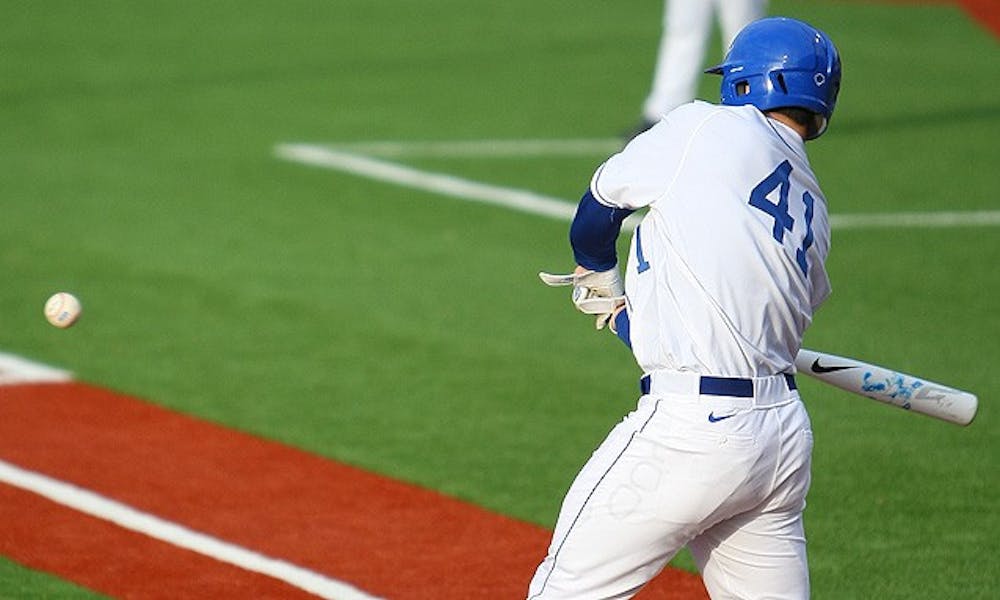After several years of escalating game times and rising concerns for player safety, the NCAA decided to take a stance against the prodigious offensive output in college baseball. Unfortunately, in the two months since altering its standard for acceptable bats, it seems the NCAA may have gone too far.
On Sept. 16, 2008 the NCAA Baseball Research Panel and Baseball Rules Committee adopted a standard of .50 in Ball-Bat Coefficient Restitution (BBCOR) testing, which represents only a marginally higher bat performance than top-quality wooden bats. It went into effect Jan. 1, 2011.
That decision had a profound impact on both Duke and other Division I teams throughout the country.
“Seeing it in action, I think they dialed the bats back too far,” head coach Sean McNally said. “It’s certainly changed the complexion of the college game and we’re still trying to figure out exactly to what degree. You can definitely see its effects in games, no question.”
Fortunately for the Blue Devils, they have not historically relied on great offensive production. Consequently, it seems Duke is coping with the transition better than some other programs across the nation.
“We’ve always been a relatively small-ball team,” senior pitcher and infielder Dennis O’Grady said. “We hit and run. We bunt. We steal. Especially this year, we have a lot of guys who can run, so in some aspects the bats are kind of playing to our advantage with our team speed and the way that we defend here.”
While Duke tends to rely on small-ball, the bat alterations have nonetheless forced McNally to reevaluate his in-game strategy this season.
“Our overall style of play has evolved a little bit,” McNally said. “I think we’re trying to bunt and hit and run and our numbers have been more aggressive on the bases early in the season. I think earlier in games you’ll see people do more to try to push a run or two across or bring the infield in to cut a run off because scoring will definitely be down.”
The Blue Devils may have adjusted their offensive approach to compensate for the BBCOR bats, but Duke’s power numbers have dropped off considerably from last season. Through eight games, Duke has hit zero home runs against inferior non-conference opponents. In comparison, the team managed .71 home runs per game last season.
“First impression as a hitter was you were kind of upset about the bats, but as a pitcher, at the same time, you love the bats,” O’Grady said. “When we first started hitting with them, we were kind of surprised how bad they actually were. But they say the more teams hit with new bats, the better they get.”
The Blue Devils can take solace in the fact that their opponents are also struggling to adapt. But the profound impact the bat change has already had on strategy and power numbers raises the question whether the change was needed in the first place.
“To be honest I don’t think it was a necessary change within the college baseball playing community,” O’Grady said. “Maybe outside people looking in at the game thought it was a little bit of a risk, especially for the pitcher. I’ve definitely been hit by comebackers, but it’s more of me making a bad pitch than the bat causing it. It’s more of what you can do to protect yourself.”
With such a small sample pool of games, it is hard to make a compelling argument that the NCAA created a new, distinct problem with its BBCOR standards. And the NCAA has stressed that the new BBCOR certification was necessary to “to enhance the safety of the student-athletes.” But some still feel that the NCAA has over-corrected a problem.
Despite the initial worries about the new standards, McNally expressed hope that the NCAA will figure out a sustainable solution to the bat dilemma.
“What I would like to see next year…is a middle ground where guys are rewarded if they drive the ball, whether it’s batting practice or in a game by hitting it out of the ballpark,” McNally said. “I’m hoping we find a middle ground next year. Safety-wise it’s a good move and certainly our pace of play is up. Hopefully we dial the bats up a bit and get it right as soon as next season.”
Get The Chronicle straight to your inbox
Signup for our weekly newsletter. Cancel at any time.

